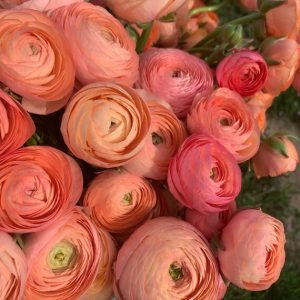 Ranunculus Amandine Salmon
Ranunculus Amandine SalmonAvailability: In stock
$23.95
Ranunculus Amandine Salmon is a highly sought after variety producing blooms in lovely shades of salmon and peach. These beauties work well with other colors and are gorgeous in design and wedding work.
Amandine varieties are typically more heat tolerant and tend to have larger blooms when compared to other ranunculus varieties.
This listing includes 10 premium corms—jumbo 7 cm in size, some of the largest available. These powerhouse corms produce vigorous plants with bigger flowers and more blooms than smaller corms. A detailed growing guide is included to help you grow with confidence.
Availability: In stock
Ranunculus Amandine Salmon is a stunning variety of ranunculus prized for its delicate, romantic appearance and vibrant, peachy-salmon hue. This flower is part of the Amandine series, which is renowned for producing larger blooms, strong stems, and an extended vase life, making it a favorite among gardeners, florists, and floral designers.
Ranunculus Amandine Salmon’s beauty, versatility, and resilience make it an exceptional choice for growers and flower lovers alike. Whether used in landscaping, floral displays, or photography, its romantic charm always stands out.
PLANTING INSTRUCTIONS:
LIGHT PREFERENCE: Full sun
STORAGE: If you aren’t planting ranunculus right away, corms can be stored in the bag they arrived them. Keep them in a cool, dry place until it is time to plant.
PLANTING TIME: In USDA Zones 7-10, Ranunculus can be planted in autumn, and successfully overwintered with the protection of a hoop house or low tunnel. If corms are exposed to temperatures below 25°F, they can freeze and eventually rot. Protection from extreme cold temperatures is essential. In colder areas (USDA zones 6b and below) or in zones 7-10 who do not have a low tunnel or hoop house, plant out in late winter or early spring.
PREPARTION: Before planting, soak the corms for 3-4 hours in room temperature water. It is important to not oversoak the corms as they will rot. As the corms soak, they will plump up, growing in size.
Before planting, it is vital to prepare the growing area. We typically add a 2-3 inch layer of organic compost to the beds and work in a slow released fertilizer.
PLANTING: Plant corms 6-9 inches apart, at a depth of 2-3 inches – if you plant too deep, the flowers will struggle to come up. Plant the corms with the “octopus tentacles” pointing down. Once planted, soak the area with water, making sure that the water penetrates at least 10 inches deep.
Please keep soil moist, not wet, at ALL times until you see germination after a few weeks. This is very important for germination success. If you let it dry out for long stretches, your germination will not be very successful.
GROWTH PHASE: During growth phase, keep your soil moist, but DO NOT overwater or they will rot. We recommend a liquid seaweed combined with a fish emulsion foliar feeding about once every 10 days during the growing season.
HARVEST: Harvest when buds are squishy like a marshmallow but not fully open, for a vase life of 7-12 days.
 Ranunculus Amandine Salmon
Ranunculus Amandine SalmonAvailability: In stock